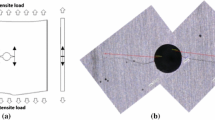Abstract
The monitoring of concrete structures with the acoustic emissions (AE) technique allows the detection of damage onset and growth. In this paper, the source location is determined by Unscented Kalman Filter (UKF) algorithm which makes use of AE signals arrival time recorded by sensors placed at the surface of the material and wave velocity known. This algorithm take into account uncertainty in time of arrival (TOA) measurements using continuous wavelet transform (CWT) analysis. The width of the fracture process zone (FPZ) was estimated from results of AE source location. The accuracy of AE location is then evaluated by comparing the results obtained with the proposed AE technique and the real crack profile. Measurements help appreciate robustness of the proposed approach with consequent potential applications in structural health monitoring of industrial parts and structures.
Access this chapter
Tax calculation will be finalised at checkout
Purchases are for personal use only
Similar content being viewed by others
References
Hadjab, H., Thimus, J.-Fr.: Fracture process zone in notched concrete beams treated by using acoustic emission. NDT, vol. 12 (2004)
Saliba, J., Loukili, A., Grondin, F., Regoin, J.-P.: Influence of basic creep on cracking of concrete shown by the Acoustic emission technique. Mater. Struct. 45, 1389–1401 (2012)
Jankowski, L.J.: Formation of the fracture process zone in concrete. Eng. Fract. Mech. 36(2), 245–253 (1990). https://doi.org/10.1016/0013-7944(90)90005-2
Shah, S.P.: Experimental methods for determining fracture process zone and fracture parameters. Eng. Fract. Mech. 35(1–3), 3–14 (1990). https://doi.org/10.1016/0013-7944(90)90178-j
Sbartaï, Z.M., Saïdoun, K.: Evaluation de l’endommagement mécanique des bétons par émission acoustique. Annales du Bâtiment et des Travaux Publics, Janvier-Mars (2014)
Ciampa, F., Meo, M.: Acoustic emission source localization and velocity determination of the fundamental mode A0 using wavelet analysis and a Newton-based optimization technique. Smart Mater. Struct. 19(4), 045027 (2010). https://doi.org/10.1088/0964-1726/19/4/045027
Tobias, A.: Acoustic-emission source location in two dimensions by an array of three sensors. Non Destruct. Test. 9(1), 9–12 (1976). https://doi.org/10.1016/0029-1021(76)90027-X
Kundu, T., Das, S., Jata, K.V.: Detection of the point of impact on a stiffened plate by the acoustic emission technique. Smart Mater. Struct. 18(3), 035006 (2009). https://doi.org/10.1088/0964-1726/18/3/035006
Coverley, P.T., Staszewski, W.: Impact damage location in composite structures using optimized sensor triangulation procedure. Smart Mater. Struct. 12(5), 795–803 (2003). https://doi.org/10.1088/0964-1726/12/5/017
Dris, E.Y., Drai, R., Bentahar, M., Berkani, D.: Adaptive algorithm for estimating and tracking the location of multiple impacts on a plate-like structure. Res. Nondestruct. Eval. 31(1), 1–23 (2020). https://doi.org/10.1080/09349847.2019.1617913
Niri, E.D., Farhidzadeh, A., Salamone, S.: Nonlinear kalman filtering for acoustic emission source localization in anisotropic panels. Ultrasonics 54, 486–501 (2014). https://doi.org/10.1016/j.ultras.2013.07.016
Dris, E.Y., Drai, R., Bentahar, M., Berkani, D., Benammar, A.: Comparative study between EKF and Geometrical methods for the Acoustic Emission source localization. Procedia Comput. .ence 148, 438–447 (2019). https://doi.org/10.1016/j.procs.2019.01.056
Kishimoto, M.K., Inoue, H., Hamada, M., Shibuya, T.: Time frequency analysis of dispersive waves by means of wavelet transform. J. Appl. Mech 62, 841–847 (1995)
Mallat, S.: A Wavelet Tour of Signal Processing. Academic Press, London (1998)
Anderson, B.D., Moore, J.B.: Optimal Filtering. Courier Dover Publications, New York (2012)
Kundu, T., Das, S., Jata, K.V.: Point of impact prediction in isotropic and anisotropic plates from the acoustic emission data. J. Acoust. Soc. Am. 122, 2057–2066 (2007). https://doi.org/10.1121/1.2775322
Jeong, H., Jang, Y.S.: Fracture source location in thin plates using the wavelet transform of dispersive waves. IEEE Trans. Ultras. Ferroelectr. Freq. Control 47(3), 612–619 (2000). https://doi.org/10.1109/58.842048
Dris, E.Y., Drai, R., Dahou, Z., Berkani, D.: EKF and UKF methods for the Acoustic emission source localization in concrete. In: Third International Conference on 1. Intelligent Computing in Data Sciences (ICDS 2019) (2019). https://doi.org/10.1109/icds47004.2019.8942244
Haase, M., Widjajakusuma, J.: Damage identification based on ridges and maxima lines of the wavelet transform. Int. J. Eng. Sci 41, 1423–1443 (2003)
Otsuka, K., Date, H.: Fracture process zone in concrete tension specimen. Eng. Fract. Mech. 65, 111–131 (2000). https://doi.org/10.1016/s0013-7944(99)00111-3
Zhang, D., Wu, K.: Fracture process zone of notched three-point-bending concrete beams. Cem. Concr. Res. 29, 1887–1892 (1999)
Haidar, K., Pijaudier-Cabot, G., Dubé, J.F., Loukili, A.: Correlations between the internal length, the fracture process zone and size effect in mortar and model materials. Mater. Struct. 38, 201–210 (2005). https://doi.org/10.1617/14053
Rossi, P., Robert, J.L., Gervais, J.P., Bruhat, D.: The use of acoustic emission in fracture mechanics applied to concrete. Eng. Fract. Mech. 35, 751–763 (1990). https://doi.org/10.1016/0013-7944(90)90158-d
Author information
Authors and Affiliations
Corresponding author
Editor information
Editors and Affiliations
Rights and permissions
Copyright information
© 2022 The Author(s), under exclusive license to Springer Nature Switzerland AG
About this paper
Cite this paper
Dris, E.Y., Drai, R., Dahou, Z., Berkani, D. (2022). Probabilistic Technique for Monitoring Damage and Cracking of Concrete. In: Kacprzyk, J., Balas, V.E., Ezziyyani, M. (eds) Advanced Intelligent Systems for Sustainable Development (AI2SD’2020). AI2SD 2020. Advances in Intelligent Systems and Computing, vol 1417. Springer, Cham. https://doi.org/10.1007/978-3-030-90633-7_14
Download citation
DOI: https://doi.org/10.1007/978-3-030-90633-7_14
Published:
Publisher Name: Springer, Cham
Print ISBN: 978-3-030-90632-0
Online ISBN: 978-3-030-90633-7
eBook Packages: Intelligent Technologies and RoboticsIntelligent Technologies and Robotics (R0)




